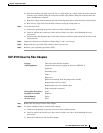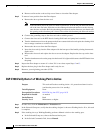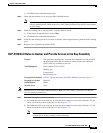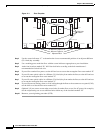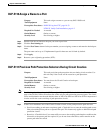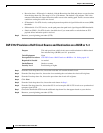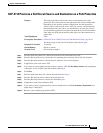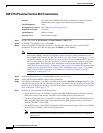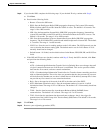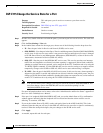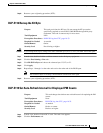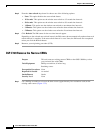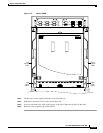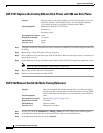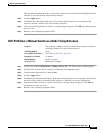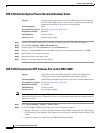
17-15
Cisco ONS 15600 Procedure Guide, R8.0
Chapter 17 DLPs E100 to E199
DLP- E114 Provision Section DCC Terminations
Step 8 If you checked OSI, complete the following steps. If you checked IP only, continue with Step 9.
a. Click Next.
b. Provision the following fields:
–
Router—Choose the OSI router.
–
ESH—Sets the End System Hello (ESH) propagation frequency. End system NEs transmit
ESHs to inform other ESs and ISs about the NSAPs it serves. The default is 10 seconds. The
range is 10 to 1000 seconds.
–
ISH—Sets the Intermediate System Hello (ISH) PDU propagation frequency. Intermediate
system NEs send ISHs to other ESs and ISs to inform them about the IS NETs it serves. The
default is 10 seconds. The range is 10 to 1000 seconds.
–
IIH—Sets the Intermediate System to Intermediate System Hello (IIH) PDU propagation
frequency. The IS-IS Hello PDUs establish and maintain adjacencies between ISs. The default
is 3 seconds. The range is 1 to 600 seconds.
–
IS-IS Cost—Sets the cost for sending packets on the LAN subnet. The IS-IS protocol uses the
cost to calculate the shortest routing path. The default metric cost for LAN subnets is 20. It
normally should not be changed.
–
Default button—If clicked, sets the default values for the Router, ESH, ISH, IIH, and IS-IS Cost
fields.
c. If the OSI and IP boxes are checked, continue with Step 9. If only the OSI is checked, click Next
and provision the following fields:
–
Mode
AITS—(Acknowledged Information Transfer Service) (Default) Does not exchange data until
a logical connection between two LAP-D users is established. This service provides reliable
data transfer, flow control, and error control mechanisms.
UITS—(Unacknowledged Information Transfer Service) Transfers frames containing user data
with no acknowledgement. The service does not guarantee that the data presented by one user
will be delivered to another user, nor does it inform the user if the delivery attempt fails. It does
not provide any flow control or error control mechanisms.
–
Role—Set to the opposite of the mode of the NE at the other end of the SDCC.
–
MTU (Maximum transmission unit)—Sets the maximum number of octets in a LAP-D
information frame. The range is 512 to 1500 octets. The default is 512. You normally should not
change it.
–
T200— Sets the time between Set Asynchronous Balanced Mode (SABME) frame
retransmissions. The default is 0.2 seconds. The range is 0.2 to 20 seconds.
–
T203—Provisions the maximum time between frame exchanges, that is, the trigger for
transmission of the LAP-D “keep-alive” Receive Ready (RR) frames. The default is 10 seconds.
The range is 4 to 120 seconds.
Step 9 Click Finish.
Step 10 Return to your originating procedure (NTP).



